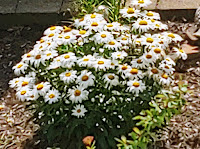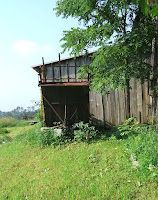The things I think and write today in blog posts, I will keep. And when I'm old and read them. . .will I laugh or will I weep?
Tuesday, August 2, 2022
HERE COMES AUGUST!
Monday, July 25, 2022
SUMMER ON MY SWING - Pondering Answers
“Hot July brings cooling showers, apricots and gillyflowers.” - Sara Coleridge
I admit as a writer I enjoy time alone to sit and think which is why I like July, why I like summer. My patio swing calls me to rest, enjoy the warm days or balmy nights, and ponder the world. It’s said curiosity is instrumental in driving our thought processes. It’s when I’m wrapped in that solitude when I ask questions which may or may not have answers:- Why can’t we see the wind?
- How does the song sparrow learn its many different songs?
- Do woodpeckers get headaches?
- What do northern squirrels think when they eat their first southern peanut from my bird feeder? Can they have an allergy to them?
- Fireflies flash in patterns that are unique to each species. Have they ever learned another pattern like we learn second languages?
- Why was the daisy chosen to be the flower plucked with the chant: He loves me, he loves me not?
And my weird wondering brain chugs along…
Maybe in our attempt to explain things in nature, we need to accept there are mysteries which may never have explanations. As humans, we like explanations. We like plans. We like the predictable.And, we like to ponder.
After all, isn’t that what
creativity really is? The use of our imaginations or original ideas in the
production of an artistic work?
So I leave you with this July
wish: Take time to rest, relax, and contemplate the world around you. And if
you get a bizarre or curious thought, drop it in the comment box below so we
all can ponder the answer!
Visit my AMAZON AUTHOR PAGE to see all my books.
Friday, July 1, 2022
CELEBRATING BARN DAY – July 10th
The second Sunday in July is designated “barn day,” when the importance of barns in the farming communities in the United States is observed. Barns are historically the center of the farm, built to accommodate animals, grain, hay, and equipment. The word barn originates from the Old English word for ‘bere,’ or barely, and ‘aem,’ which means storage space.
Throughout our lands, there are many different types and styles of barns, built and designed to reflect the type of farming that occurred there. In northeastern Pennsylvania, where I grew up, our dairy barn was a bank barn which meant it was built into a bank allowing for easy ground access to both the upper and lower floors. The upper floors accommodated haylofts where first loose hay and then baled hay were stored for the cattle housed on the lower floor.
Most barns in northeastern Pennsylvania were constructed of hemlock, a very hardy wood which seasons to a light gray color. The eastern hemlock is the state tree of Pennsylvania and large, plentiful stands existed in the 1800s.
By design, our barn was fashioned after a design called the Dutch Barn with its hip or gambrel roof which had two symmetrical slopes on two sides, with the lower slope steeper than the upper one. However, the barn itself was more rectangular, like the English and German barns, and the broad expansive side had wide doors on tracks that opened and allowed for wagons to enter directly into hay loft, making unloading the hay load easier.How did they get the hay into the barn? A long rail or
track ran along the inside length of the roof, from peak to peak, and
accommodated a double harpoon hay fork, pulleys, and trip rope. Once the fork,
with its two giant tines, was secured into a bundle of hay, a horse—and later a
tractor—pulled the stack of hay up and onto the track. After delivering it to
the proper location, a yank on an attached rope would trip the hay fork to release
its load. I often worked the mow. Using a pitch fork, I dragged layers of hay
to the far corner and edges of the loft to even it out.
So what do you do on Barn Day? Why not take a ride in the country and go looking for old barns? They are a disappearing structure on our rural landscape as the farming industry has slowly faded over the years and the barn buildings have gone to disrepair.
Visit my Amazon Author Page for all my books
Wednesday, June 1, 2022
IT'S JUNE!
Suddenly it’s June. It’s the month I’ve been waiting for all year. June ushers in summer for me here in Pennsylvania.
As a farm kid, it was the month of clover, alfalfa, and grasses drying in the rows in our fields. Smells were everywhere: The odor of gasoline from the tractor, hay truck, and lawn mower. The sweet fragrance of summer rag roses in the yard. The earthy aroma of rain as it approaches to soak the ground. The whiff of mint circling the old oak spring boxes in the pastures. These were all mixed together in the daily harmony of farm life.There was also the unexpected that happened to throw a person off kilter. It was the black snake slithering over a stone wall as we tramped down the fields to the pasture to bring the herd of cows home for evening milking. Better yet, it was those aggravating times when the black racer’s lazy cousin, lying in the low branches of a hemlock tree, would drop down in front of the herd and send the cows racing willy-nilly up into the wooded hillside where we had to regroup them one by one. And we always counted. Numerous times we counted those cows to be sure we had them all before setting out for home.
When evening fell, we’d sit out on our front porch to catch a fading breeze and watch the barn swallows circle the sky and deftly snatch the last mosquito. Lightening bugs danced above the lawn and in the bushes. Windows were thrown open wide. If you were lucky, you had a window fan on the hottest night. The hum of insects in the grasses and trees were the songs that lulled us to sleep. Far off, you could hear the neighbor’s dog bark, upset by some night creature nearby. And everyone listened for the eerie hoots of an owl on his evening hunt.
When people ask if summers were the hard times of farm life, I’d have to say, they were the busy and tiring times with long days. But they were the good times.
It was June. It was summer. And it felt wonderful.
VISIT MY AMAZON AUTHOR PAGE FOR ALL MY BOOKS













